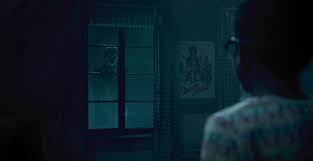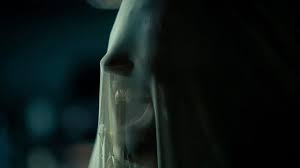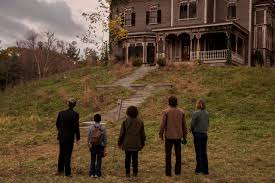Salem’s Lot (2024)

Salem’s Lot (2024) Review: A Chilling Return to Stephen King’s Vampire Nightmare
Stephen King’s ‘Salem’s Lot has long been hailed as one of the most terrifying vampire novels ever written. Over the years, it has seen multiple adaptations, but the 2024 version, directed by Gary Dauberman, aims to bring a fresh cinematic take on the iconic horror tale. With an updated visual style, a talented cast, and a commitment to staying true to King’s chilling vision, ‘Salem’s Lot (2024) revives the nightmarish story for a new generation of horror fans.
Synopsis: The Dark Secrets of Jerusalem’s Lot
The film follows Ben Mears (played by Lewis Pullman), a successful writer who returns to his childhood hometown of Jerusalem’s Lot, Maine, hoping to confront his past traumas and find inspiration for his new book. However, upon his arrival, he discovers that an ancient evil has taken root in the seemingly quiet town.
Ben soon learns that the mysterious Marsten House, a place that has haunted his nightmares for years, is now occupied by the enigmatic Kurt Barlow, an unseen but sinister figure. As residents of the town begin to disappear or turn into bloodthirsty vampires, Ben and a small group of survivors—including Susan Norton (Alfre Woodard), Dr. Cody (Bill Camp), and young Mark Petrie (Jordan Preston Carter)—must confront the growing terror before Jerusalem’s Lot is completely consumed by darkness.
Unlike the romanticized or action-oriented vampires that have dominated recent pop culture, ‘Salem’s Lot (2024) brings back the terrifying, monstrous creatures reminiscent of Nosferatu-style horror. The film’s vampires are grotesque, feral, and genuinely frightening, embodying the nightmarish essence that King envisioned in his novel.
Kurt Barlow, played by Willem Dafoe, is a particularly standout character. Unlike some adaptations where Barlow appears more human-like, this version leans into his monstrous nature. Dafoe’s chilling performance, combined with practical effects and minimal CGI, makes Barlow one of the most horrifying vampires in modern horror cinema.
Building Suspense: Slow Burn Horror Done Right
One of the film’s greatest strengths is its pacing. Rather than relying on excessive jump scares, ‘Salem’s Lot (2024) builds tension gradually, creating a lingering sense of dread. The eerie silence of the town, the unsettling performances by the cast, and the gradual unveiling of the vampire plague contribute to an ever-mounting horror.
The cinematography by Michael Burgess (known for The Nun II) uses dim lighting, eerie shadows, and a muted color palette to enhance the unsettling atmosphere. The Marsten House, in particular, is a visually haunting setting that feels like a character in itself—its looming presence over the town amplifies the sense of inevitable doom.
Key Performances: A Strong Cast Brings Depth to the Horror
- Lewis Pullman as Ben Mears: Pullman delivers a strong performance, portraying Ben as both a haunted writer and an unlikely hero. His emotional depth adds layers to the character, making his confrontation with the evil all the more impactful.
- Alfre Woodard as Susan Norton: Susan is given more agency in this adaptation, making her a compelling and intelligent character rather than just a love interest. Woodard’s performance adds gravitas to her role.
- Jordan Preston Carter as Mark Petrie: One of the film’s standout performances, Mark is portrayed as a resilient and determined young boy whose love for horror comics helps him understand and fight against the vampires.
- Willem Dafoe as Kurt Barlow: Dafoe’s portrayal of Barlow is nightmarish, blending elements of classic horror monsters with his signature intensity.

Themes and Symbolism: The Fear of Isolation and Corruption
As with all great horror stories, ‘Salem’s Lot is more than just a tale of vampires—it is a deep exploration of isolation, small-town secrets, and the corruption of innocence.
- Isolation and the Fear of the Unknown: The film emphasizes how isolation makes individuals vulnerable to supernatural forces. Ben’s return to Jerusalem’s Lot is met with suspicion, mirroring the town’s growing paranoia.
- The Corruption of a Community: The slow spread of vampirism serves as a metaphor for how evil can silently infiltrate and destroy an entire community. Much like in King’s novel, the town succumbs to darkness not just because of supernatural forces but also due to its own complacency and fear.
- Faith vs. Fear: The battle against Barlow is not just physical but also spiritual. The film retains the novel’s exploration of faith and belief, particularly through Father Callahan’s struggle with his own convictions.
Strengths of the Film
- Faithful to Stephen King’s vision while making necessary updates for a modern audience.
- Strong performances from a talented cast, particularly Willem Dafoe as Kurt Barlow.
- Terrifying practical effects that bring back classic horror elements.
- Atmospheric cinematography that builds slow-burning dread.
- A well-paced narrative that doesn’t rush but allows fear to gradually sink in.

Potential Weaknesses
While ‘Salem’s Lot (2024) excels in many areas, it does have a few minor shortcomings:
- A slow start: Some viewers may find the film’s slow build too gradual before the horror fully kicks in.
- Lack of significant new twists: While faithful to the book, it doesn’t introduce many surprises for those familiar with the story.
- Limited screen time for Barlow: Willem Dafoe’s chilling performance is memorable, but some might wish for more scenes featuring the terrifying vampire.
Final Verdict: A Must-Watch for Horror Fans
‘Salem’s Lot (2024) successfully brings Stephen King’s terrifying vampire tale to the big screen in a way that honors the original story while adding a modern cinematic touch. With its eerie atmosphere, terrifying creatures, and compelling performances, it stands as one of the best horror adaptations of recent years. While some may find its slow-burn approach to be deliberate, true horror fans will appreciate the tension, dread, and ultimate payoff.